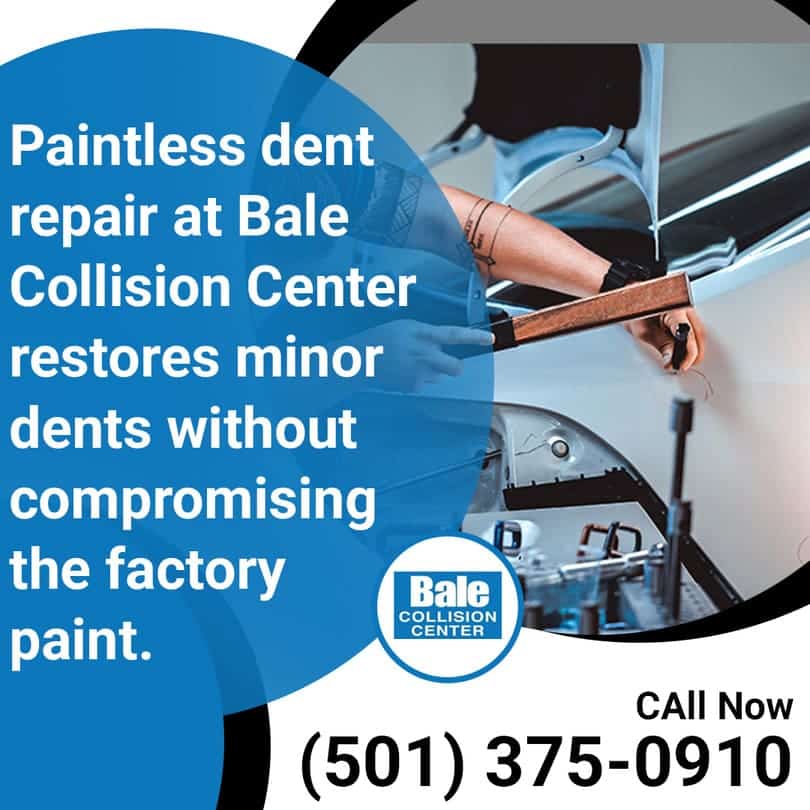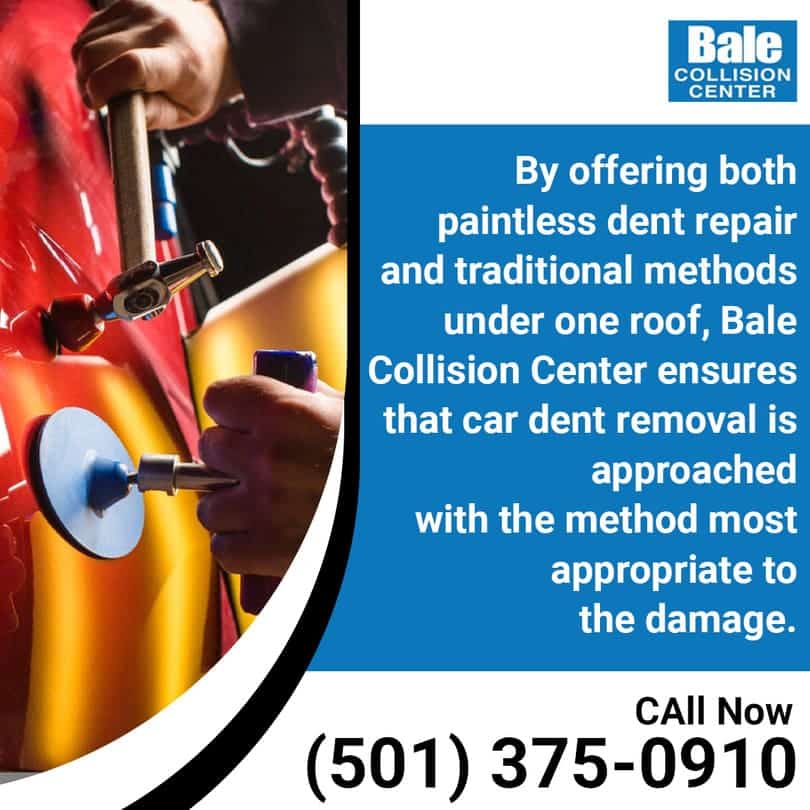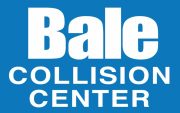When your vehicle sustains damage, the repair method you choose makes a significant difference in cost, quality, and timeline. Understanding when paintless dent repair (PDR) provides the right solution versus traditional auto body repair helps you make informed decisions that protect your investment. The decision hinges on damage characteristics, location, and paint condition rather than simply choosing the most affordable option.
At Bale Collision Center (Downtown), our technicians evaluate damage systematically to determine the most effective car dent removal approach. With decades of experience, we’ve seen how choosing the wrong repair method can lead to poor results, higher costs, and reduced vehicle value.

Understanding Paintless Dent Repair vs Traditional Methods
The fundamental difference between these repair approaches lies in their methodology and application scope.
How PDR Actually Works
Paintless dent repair manipulates damaged metal back to its original position without disturbing the vehicle’s factory finish. Technicians access the damage from behind the panel using specialized tools that gradually massage the metal outward. This process relies on the metal’s natural memory to return to its original shape.
Success depends on several critical factors: paint flexibility, metal type, dent depth, and access points. Modern automotive paints have improved elasticity compared to older formulations, making PDR viable for larger dents than previously possible.
Traditional Repair Process Components
Traditional auto body repair involves multiple stages: damage assessment, metal preparation, filler application, sanding, priming, painting, and finishing. Each step requires specific materials, equipment, and drying time.
This method becomes necessary when paint damage occurs, metal stretching exceeds elastic limits, or when structural integrity requires attention. While more time-consuming and expensive, traditional repair can address virtually any type of damage.
What Vehicle Damage Qualifies for PDR?
Specific damage characteristics determine PDR suitability more than damage size alone.
Storm-Related Vehicle Damage
Arkansas weather patterns create unique challenges for vehicle owners. Severe events have occurred throughout the state recently, including hailstorms with stones reaching lime and softball sizes that caused extensive damage to vehicles and property.
Hail damage repair represents PDR’s most common application because these impacts typically create uniform, shallow depressions. However, large hailstones can exceed PDR limitations by cracking paint or creating extremely deep impressions that stretch the metal beyond repair.
Storm debris, falling branches, and wind-blown objects create different damage patterns that require individual assessment. The impact angle, object shape, and contact duration all influence whether hail damage repair will be successful.
Everyday Collision Scenarios
Parking lot incidents account for numerous minor vehicle damages that PDR can address effectively. These situations often involve low-velocity impacts that create surface depressions without paint damage.
Shopping cart impacts, door contact between vehicles, and minor backing incidents frequently produce damage within PDR parameters. The key factor remains paint integrity rather than dent size or location.
Contact with fixed objects like concrete barriers, posts, or garage doors may create damage beyond PDR capabilities if the impact velocity or object characteristics cause paint disruption or metal stretching.
Vehicle-Specific Considerations
Different vehicle designs present varying repair challenges. Luxury vehicles often use aluminum panels that require specialized PDR techniques and an increased cost due to material properties.
European vehicles, high-end models, and those with specialized paint finishes may require additional expertise and time investment. The vehicle’s age, construction methods, and previous repair history also influence repair options. Electric vehicles present unique considerations due to battery placement, sensor locations, and manufacturer-specific repair requirements that may affect PDR accessibility.
At Bale Collision Center, our dent removal services address these damage scenarios with proper assessment and technique selection. Our certified PDR technicians understand the nuances of different vehicle types and damage patterns, and apply the appropriate repair method for best results.
When Traditional Auto Body Repair Becomes Necessary
Certain damage types exceed PDR capabilities and require conventional repair methods for proper restoration.
Paint and Surface Damage Indicators
Any visible paint disruption eliminates PDR as a viable option. Scratches reaching the metal, paint chips, or clear coat damage require refinishing work that PDR cannot provide.
Impact damage that creates sharp edges, tears in the metal, or visible deformation patterns typically indicates metal stretching beyond PDR limits. These situations require traditional bodywork to restore proper contours and strength.
Structural and Safety Concerns
Vehicle safety systems require proper panel alignment and structural integrity. Modern vehicles incorporate crumple zones, reinforcement areas, and sensor mounting points that demand precise restoration.
When damage affects these critical areas, traditional repair methods ensure proper restoration of safety features and structural performance. Advanced driver assistance systems (ADAS) may require recalibration after panel work, regardless of the repair method.
Frame damage, suspension mounting point distortion, or door alignment issues require conventional repair techniques to restore vehicle safety and operation.
Access and Location Limitations
Panel design affects repair feasibility. Areas where technicians cannot access the damage from behind, such as reinforced sections or double-wall construction, may require alternative car dent removal approaches.
Damage near panel edges, body seams, or reinforcement areas often presents access challenges that make PDR impractical or impossible. These locations may require partial disassembly or conventional repair methods. Vehicle architecture, particularly in modern designs with complex curves and reinforcement patterns, can limit tool access necessary for effective PDR work.
Bale Collision Center’s certified PDR team recognizes these limitations and provides honest assessments about when paintless dent repair remains viable versus when traditional methods serve the customer better. Our dent removal services in Downtown Little Rock, Arkansas, combine both capabilities to make sure the vehicle restoration is proper regardless of damage complexity.
Cost Analysis: PDR vs Traditional Repair Methods
Financial considerations extend beyond initial repair costs to include long-term value impacts.
PDR Pricing Structure
Professional PDR services use standardized pricing matrices that account for dent quantity, size categories, and difficulty factors. Dent size classifications commonly use coin references for standardized measurement: dime-sized (smallest), nickel-sized, quarter-sized, and half-dollar-sized, with oversized dents larger than a half-dollar requiring separate pricing considerations.
Material factors also impact costs. Aluminum panels require specialized techniques and cost more than steel panel repairs. High-strength steel presents similar challenges and cost increases.
Location factors also affect pricing. Roof rails with double-wall construction, extended cab truck roofs, and areas requiring panel removal for access may include additional charges reflecting increased difficulty.
Traditional Repair Cost Factors
Traditional repair pricing includes material costs, labor time, and facility overhead. Paint materials, primers, fillers, and finishing products contribute to total costs.
Labor time varies considerably based on damage extent, vehicle design, and quality requirements. Multiple process steps, each requiring specific drying or curing time, extend repair duration and associated costs.
Insurance considerations play a major role in traditional repair decisions. Coverage limits, deductible amounts, and preferred shop relationships can influence car dent removal method selection and final costs.
Long-Term Value Implications
Vehicle resale value benefits from maintaining factory paint finish whenever possible. PDR preserves the original finish quality that cannot be perfectly replicated through refinishing.
However, inadequate repair attempts can decrease vehicle value more than proper traditional repair. Professional assessment makes sure the repair method matches damage requirements for long-term results.
CarFax reporting and vehicle history considerations may favor PDR when applicable, as this method often avoids formal accident reporting requirements.
Timeframe Expectations for Different Repair Methods
Repair duration affects vehicle availability and daily routine disruption.
PDR Completion Times
Simple door dings and minor dents often require minimal time investment. Small, accessible damage may be completed within one to two hours, allowing same-day service.
Multiple small dents, common in hail damage scenarios, require systematic attention to each affected area. Moderate hail damage typically requires one to three days, depending on dent quantity and distribution.
Extensive hail damage repair involving hundreds of impacts may require up to a week for complete restoration. Quality PDR work cannot be rushed without compromising results.
Traditional Repair Timelines
Conventional repair involves sequential processes that cannot be accelerated beyond material limitations. Primer and paint applications require specific drying and curing times regardless of facility scheduling.
Complex repairs involving multiple panels, structural work, or specialty finishes may require several weeks for completion. Parts availability, insurance approval processes, and quality control procedures all influence the timeline. Weather conditions, facility capacity, and technician availability also affect traditional repair scheduling in ways that PDR typically avoids.
At Bale Collision Center, we provide realistic timeframe estimates based on damage assessment and current facility capacity. Our certified PDR services prioritize quality over speed, ensuring each repair meets our standards while minimizing inconvenience to your daily schedule.
Bale Collision Center: Leading Dent Removal Services in Downtown Little Rock, AR
Your choice of repair facility directly impacts repair quality, timeline, and overall experience during vehicle restoration.
Our Certification and Training Excellence
Bale Collision Center maintains I-CAR Gold certification, representing the industry’s highest training standard for collision repair techniques. This certification requires ongoing education to maintain current knowledge of evolving repair methods and vehicle technologies.
Our technicians are I-CAR Platinum-certified and ASE-certified, which provides additional validation of expertise in specific automotive systems. These credentials demonstrate our commitment to professional development and industry best practices that benefit every customer.
We stay current with manufacturer-specific training as vehicle technology advances. Our certified facility follows OEM repair procedures and material requirements to restore the vehicle properly, regardless of vehicle make or model.
Advanced Equipment and Facility Capabilities
Our professional PDR in Downtown Little Rock, AR, utilizes specialized tools, lighting systems, and controlled work environments. This precision and consistency come from our dedicated shop facilities designed for ideal repair conditions.
Bale Collision Center employs modern diagnostic equipment that enables thorough damage assessment and proper repair completion. This technology integration separates our professional operations from basic repair services available elsewhere. We maintain both PDR and conventional repair capabilities under one roof.
Insurance Relationships and Customer Protection
We maintain established working relationships with major insurance companies, streamlining claims processing and approval procedures. These relationships benefit customers through reduced paperwork and faster service initiation.
Our direct repair programs (DRP) with insurers like State Farm, Allstate, Liberty Mutual, USAA, Nationwide, Safeco, AAA, and Hanover provide advantages in claims handling while maintaining your right to choose your preferred repair facility.
Customer-Focused Service Experience
At Bale Collision Center, we prioritize clear communication throughout the entire repair process. Our team provides regular updates on repair progress, ensuring you stay informed about your vehicle’s status and expected completion timeline.
Our technicians explain damage assessment findings and repair method recommendations. This transparent approach helps customers understand their options and make informed decisions about their vehicle restoration.
Quality Assurance and Safety Standards
Every paintless dent repair project undergoes thorough quality inspection before customer delivery. Our inspection process ensures repairs meet both our internal standards and industry best practices for long-lasting results.
Bale Collision Center follows strict safety protocols during all repair procedures, protecting both our technicians and customer vehicles. Our controlled environment eliminates variables that can compromise repair quality in mobile or temporary service settings. We maintain detailed documentation of all repair procedures, providing customers with complete records of work performed.

Trust Bale Collision Center for Expert Car Dent Removal
Bale Collision Center combines decades of experience with modern technology and certified expertise to deliver superior dent removal services in Downtown Little Rock, AR. Our I-CAR Gold and ASE-certified team uses advanced diagnostic equipment to assess damage completely before recommending repair methods.
We understand vehicle damage creates stress and inconvenience. Our systematic approach minimizes these concerns through clear communication, realistic timelines, and attention to detail.
Need expert dent removal services in Downtown Little Rock, AR? Contact Bale Collision Center at (501) 375-0910 or bccdowntown@baleautomotive.com. Our certified technicians will assess your damage honestly and recommend the car dent removal approach that best serves your needs. Experience the difference that 72 years of Arkansas service makes in auto body repair quality.
